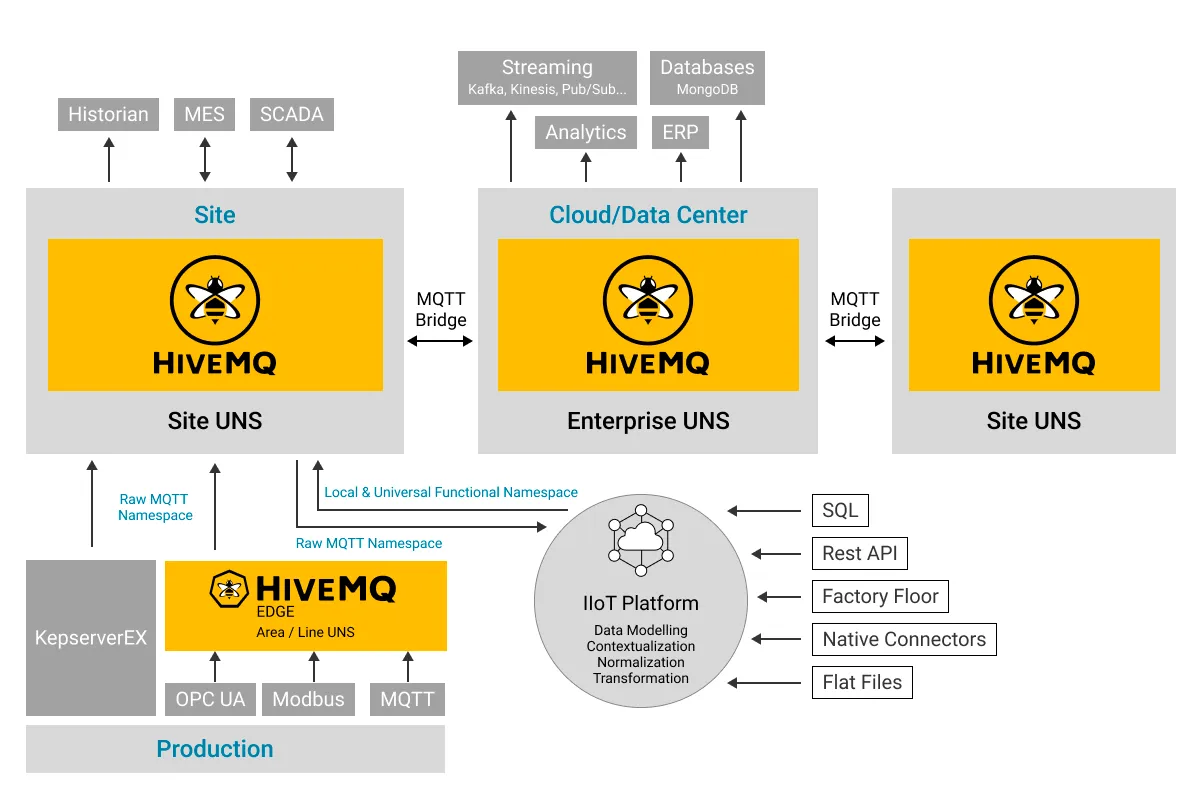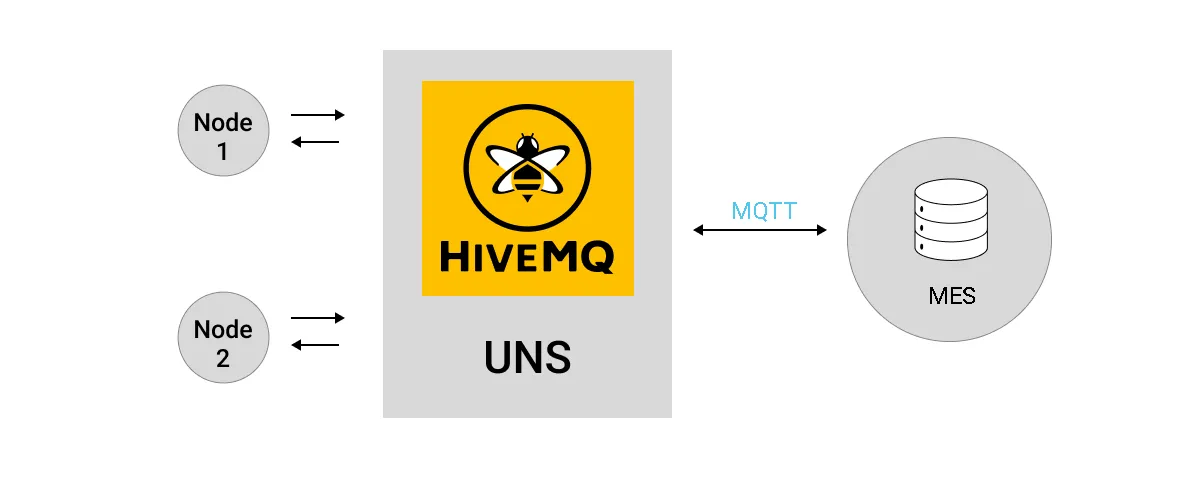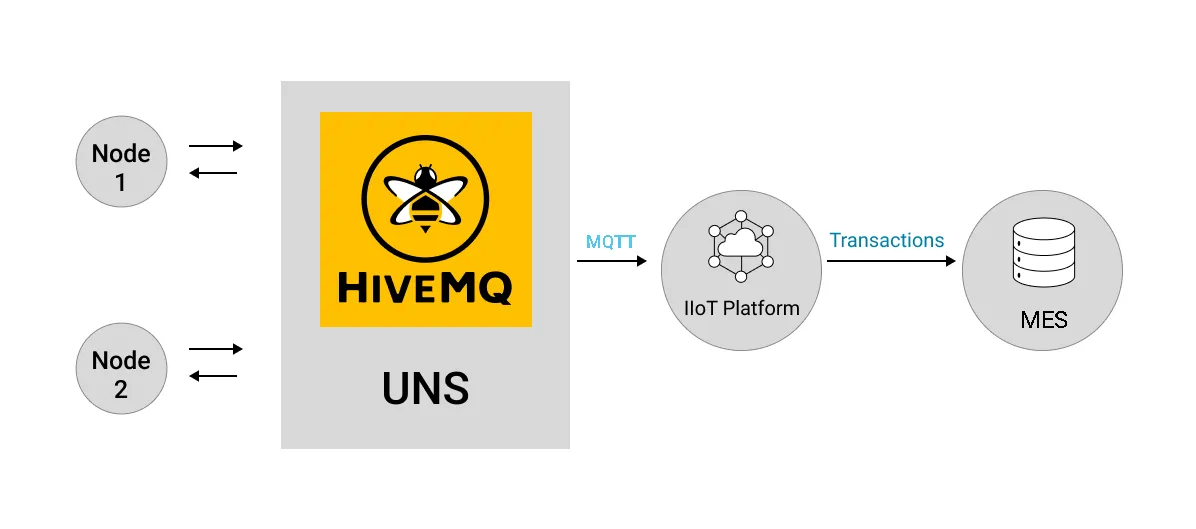Integrating an MES into Unified Namespace
The Unified Namespace (UNS) acts as the central nervous system of an integrated manufacturing environment, providing a structured and coherent data architecture that ensures interoperability among disparate systems and platforms.
It offers a common language and framework for data integration; from edge devices capturing real-time operational data on the plant floor to Enterprise Resource Planning (ERP) systems managing business processes, and to Manufacturing Execution Systems (MES) executing manufacturing operations.
This article explores how the MES system can be integrated into a Unified Namespace as part of a digital transformation for manufacturing organizations.
Understanding MES in the Context of Modern Manufacturing
Before delving into the specifics of MES integration into UNS, it's imperative to understand what MES is and its significance in manufacturing operations. MES is the critical intermediary layer connecting the shop floor with the enterprise's strategic level.
It encompasses a suite of functionalities essential for effectively executing manufacturing operations. These functions include scheduling, managing work orders, calculating Overall Equipment Effectiveness (OEE), tracking downtime, and more. Unlike SCADA systems, which are universally applied for supervisory control and data acquisition, MES systems are inherently flexible and designed to mirror and enhance the unique operational processes of a manufacturing facility.
The versatility of MES systems allows them to adapt to the diverse needs of manufacturing operations, ranging from batch processing and discrete manufacturing to continuous production environments. Each MES function — from scheduling to quality management — is pivotal in ensuring that manufacturing operations are executed efficiently, products meet quality standards, and resources are utilized optimally.
The Role of Unified Namespace in MES Integration
Integrating MES within this architecture involves mapping out the MES functions within the semantically structured information hierarchy of the Unified Namespace, ensuring that data is accessible across the organization without friction. This process not only facilitates real-time decision-making but also enhances the agility and flexibility of manufacturing operations.
 Integrating MES Within Site Level Unified Namespace, Powered by HiveMQ MQTT Platform
Integrating MES Within Site Level Unified Namespace, Powered by HiveMQ MQTT Platform
Subscribing to Unified Namespace Data from an MES System
If the Manufacturing Execution System (MES) supports MQTT communication directly, it can connect to the MQTT broker. This broker acts as a central hub that holds the Unified Namespace as a shared and accessible data framework. Through this connection, the MES can access necessary information to calculate business performance metrics. It can also share Key Performance Indicators (KPIs) within the system to enhance real-time, data-driven decision-making across the enterprise.
 On the other hand, if the MES doesn't support MQTT communication by default, it's common to employ an Industrial Internet of Things (IIoT) or DataOps platform. These platforms act as intermediaries, enabling the MES to interact with the Unified Namespace.
On the other hand, if the MES doesn't support MQTT communication by default, it's common to employ an Industrial Internet of Things (IIoT) or DataOps platform. These platforms act as intermediaries, enabling the MES to interact with the Unified Namespace.
 By tapping into the Unified Namespace, the MES can subscribe to data streams that provide both real-time and historical insights from the production floor. This includes information on machine status, production rates, quality metrics, and more. The MES uses this comprehensive data to compute important performance indicators, such as Overall Equipment Effectiveness (OEE) and production efficiency. It also supports functions like Production Tracking and Resource Scheduling, among others.
By tapping into the Unified Namespace, the MES can subscribe to data streams that provide both real-time and historical insights from the production floor. This includes information on machine status, production rates, quality metrics, and more. The MES uses this comprehensive data to compute important performance indicators, such as Overall Equipment Effectiveness (OEE) and production efficiency. It also supports functions like Production Tracking and Resource Scheduling, among others.
Publishing MES Data into the Unified Namespace
After calculating the business performance metrics, the Manufacturing Execution System (MES) publishes them to the Unified Namespace (UNS). Along with these metrics, the MES also periodically updates the UNS with essential manufacturing information like Work Orders and Production Schedules as needed. Similarly, when the MES requires data from the Enterprise Resource Planning (ERP) system, it subscribes to the relevant data within the ERP namespace of the UNS.
This act of pushing data to a central hub of information is crucial for several reasons. First, it ensures that performance indicators are readily and openly accessible to other systems and stakeholders within the organization, facilitating informed decision-making across various levels. Second, it enriches the UNS with contextual data, transforming raw operational data into actionable insights.
Moreover, having performance metrics, such as Overall Equipment Effectiveness (OEE), available in an open data ecosystem like the UNS enables a more nuanced and context-aware approach to operational management. Entities that require this information — such as dashboards, reporting tools, or even automated systems tasked with optimizing production schedules — can subscribe to these metrics. This capability fosters an environment where decisions are made not just based on operational data but are informed by the overall effectiveness and efficiency of the manufacturing process.
Key Steps in Integrating MES with Unified Namespace
1. Establish an Edge Namespace for Collecting MES Data
Begin by organizing all the raw data from Programmable Logic Controllers (PLCs) into what you would call an edge namespace. This includes data critical for calculating MES Key Performance Indicators (KPIs) and for the successful execution of MES operations. Essentially, map out and categorize each data element that will be utilized in MES processes.
2. Implement DataOps
Once you've collected the raw data into an edge namespace, the next phase involves processing this data to make it usable for the MES system and other related systems. This step includes:
Data modeling to define the data in structured formats.
Normalization to ensure data consistency.
Contextualization to add meaning to the data.
Data transformation to convert data into the required formats.
This processed data is then published back into the UNS for MES usage, which allows MES to perform its functions effectively. This may also involve adapting data structures to standards such as ISA-95 Object models, OPC UA companion specifications, or custom models tailored to your organization.
3. Set Up a Namespace for MES Functions
Next, create a specific namespace within your UNS dedicated to MES operations. This namespace should store information about various MES functions, including essential Key Performance Indicators (KPIs) related to production efficiency, quality management, and maintenance tasks, such as Overall Equipment Effectiveness (OEE), First Pass Yield, and Mean Time to Repair. The detail and number of namespaces you decide to integrate into your UNS depend on the system architect and the specific needs of your organization.
The Strategic Importance of Function-Centric MES Integration
A strategic aspect of MES integration is the emphasis on functions rather than the system itself. This approach advocates for a modular and function-centric design of the MES, enabling more flexible and scalable integration strategies. By concentrating on the essential functions of MES, such as scheduling, downtime tracking, and statistical process analysis (SPA), manufacturers can tailor the integration to meet their specific operational needs, enhancing the system's responsiveness and adaptability.
This approach of integrating MES into the Unified namespace highlights a crucial perspective shift: moving away from considering MES as a monolithic entity and towards understanding it as a collection of critical manufacturing functions. This shift is not just semantic; it reflects a deeper understanding of the role of MES in manufacturing operations.
Adopting a function-centric perspective towards MES integration offers several strategic advantages. It encourages manufacturers to think beyond the constraints of traditional system boundaries, focusing instead on how specific MES functions can contribute to operational excellence. This perspective ensures that the integration is driven by business needs and operational goals rather than being limited by technical considerations.
Moreover, a function-centric approach facilitates the identification and prioritization of MES functions that offer the highest value to the organization. By focusing on these key areas, manufacturers can allocate resources more effectively, ensuring that the integration efforts yield tangible improvements in operational efficiency and productivity.
Conclusion
By embedding MES functions within the UNS's structured data architecture, organizations unlock the potential for seamless interoperability between various systems, from the shop floor to the top floor, enhancing real-time decision-making and operational agility. The future of manufacturing lies in the ability to adapt and respond swiftly to changing market demands and operational challenges. In this context, the strategic integration of MES with UNS is not just an option but a necessity for those looking to thrive in the rapidly evolving industrial landscape.
Next in our UNS Essentials series, we discuss how to integrate an ERP system into a UNS using an MQTT broker. Read on.

Kudzai Manditereza
Kudzai is a tech influencer and electronic engineer based in Germany. As a Sr. Industry Solutions Advocate at HiveMQ, he helps developers and architects adopt MQTT and HiveMQ for their IIoT projects. Kudzai runs a popular YouTube channel focused on IIoT and Smart Manufacturing technologies and he has been recognized as one of the Top 100 global influencers talking about Industry 4.0 online.
